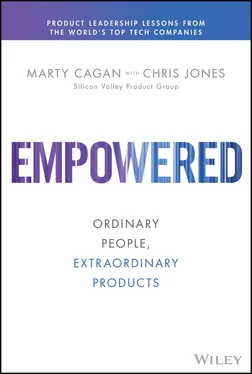At this point, you're ready to go out there and meet real users and customers.
To set your expectations, when I (Marty) first took responsibility for a new B2B product, my manager wanted me to visit 30 customers (and further, he insisted that half be from outside the United States) before making any meaningful decisions. I don't think that the number 30 is special, but I can tell you it's not just 2 or 3. I typically recommend at least 15 customer visits as part of new PM onboarding.
When I returned from that trip, I had progressed from knowing virtually nothing to knowing as much as anyone in our organization. I leveraged what I learned—and the people I met and the relationships I established—for years.
Once you're actually sitting down with users and customers, a whole other topic is the techniques we use to learn, but that's the discovery techniques topic. With every interaction, at the very least, you're looking to learn: Are the customers who you think they are? Do they have the problems you think they have? How do they solve that problem today? What would it take to get them to switch?
Note that there are some obvious differences between customers that are businesses versus consumers, but the principle is the same in either case.
Note also that if you are joining an existing team with a skilled product designer and tech lead, then you absolutely want to learn as much from them as possible. And if you're joining a new team, then you want to include these two key people with you during your learning.
There are generally three types of data and tools that the new product manager will need to achieve competence on. There is typically one tool that contains the data about how users interact with your product—user analytics. Another tool typically contains data about the sales cycle for your product—sales analytics. And a third typically shows how this data is changing over time—data warehouse analytics.
Realize that achieving competence for each of these tools means two things. First, that you know how to answer questions with that tool—you're learning how to operate it. Second, you need to understand what the data in the tool is trying to tell you.
Your go‐to resource for coming up to speed on the data (tool operation and data semantics) is usually one of the company's data analysts. This is another key relationship for the new product manager to establish. But to be clear, unless you have a full‐time data analyst or data scientists embedded in your product team, they are not there for you to delegate work to them. They are there to educate and empower you to answer questions with data.
This topic is intertwined with the topic below about understanding your business. Every product has a set of key performance indicators (KPIs) that collectively describe your product's health, and while data tools will help you understand where you're at, your business will dictate which KPIs are most important for you to focus on.
Industry and Domain Knowledge
In general, the product manager is expected to become competent on the domain. This is, of course, different for every product. Media products are different from developer products, which are different from advertising‐technology products. Fortunately, in most cases, there is a wealth of easily accessible knowledge just an internet search away.
However, with certain products in very specialized domains (such as taxation, surgical devices, and regulatory compliance), there will usually be an in‐house resource available to all of the product managers who is an acknowledged expert on the domain. These people are sometimes called subject matter experts or domain experts , and this person is another important relationship for the product manager to establish. The PM is not expected to become as knowledgeable about the domain as these experts, but she does need to learn enough to engage and collaborate effectively.
In terms of broader tech industry knowledge, there are many industry analysts that provide analysis and insights. 1
Key to industry knowledge is identifying which industry trends are expected to be relevant to the PM's product. The first step is to identify the trends, and then there may be some education needed to understand what the trend or technology enables and what the capabilities and limitations may be.
Also included in industry knowledge is competitive analysis. Product marketing is a good resource to get started here, but the product manager will need to have a deeper understanding of the offerings, vision, and strategy of each of the major players in the landscape.
When I coach product managers on competitive analysis, I like to ask the PM to evaluate the top three to five players in the space and to write up a narrative comparing and contrasting the strengths and weaknesses of each player—highlighting opportunities.
Business and Company Knowledge
For most new product managers, understanding how their own business works requires the greatest amount of work. But this is often the essential difference between competent product managers and those who are not.
One way I like to get started on this is to have the new product manager fill out a business model canvas (any of the variants are fine for this) for their product. It is a quick and easy way to help the product manager quickly realize the areas she may not yet understand.
Sales and Marketing—Go‐To‐Market
The go‐to‐market strategy is an essential aspect of every product. This describes how our product makes it into the hands of users and customers. It applies to every type of product—from consumer to enterprise—but it's usually most involved when selling to businesses. Your product may get sold through a direct sales force, or an indirect channel such as resellers, or directly to your customers.
The sales process starts with marketing, which itself has many different strategies and techniques. Ultimately, there's always some type of funnel starting with people becoming aware you exist, and hopefully proceeding through to the point where they are an active user and customer.
The new PM needs to understand the entire funnel from awareness to trials to onboarding. It's especially important to understand the capabilities and limitations of the sales channel. Your colleagues in product marketing are normally your go‐to resource for learning about your go‐to‐market strategy.
Finance—Revenue and Costs
It's also essential for the new product manager to gain a deep understanding of the financials regarding her product. This involves both the revenue side as well as costs.
I've long advocated making a friend in finance for this purpose. There is a set of financial‐related KPIs for every product, and you need to first understand what those KPIs are (e.g., lifetime value of the customer), and what they mean (e.g., how is lifetime value calculated?). Finally, you need to learn where your product stands (e.g., is your lifetime value sufficient compared to your cost to acquire new customers?). 2
Legal—Privacy and Compliance
Another critical aspect to your business is legal. These issues mainly relate to privacy, security, compliance, and increasingly, ethics. As with finance, establishing a relationship with someone in legal who can help the new PM understand legal constraints is important—not just in coming up to speed, but also when considering new product ideas.
Business Development—Partnerships
Most products today involve some number of partnerships. It may be a technology partner that's used to deliver your products or services, or it may be a sales or marketing partnership to acquire new customers.
Читать дальше











